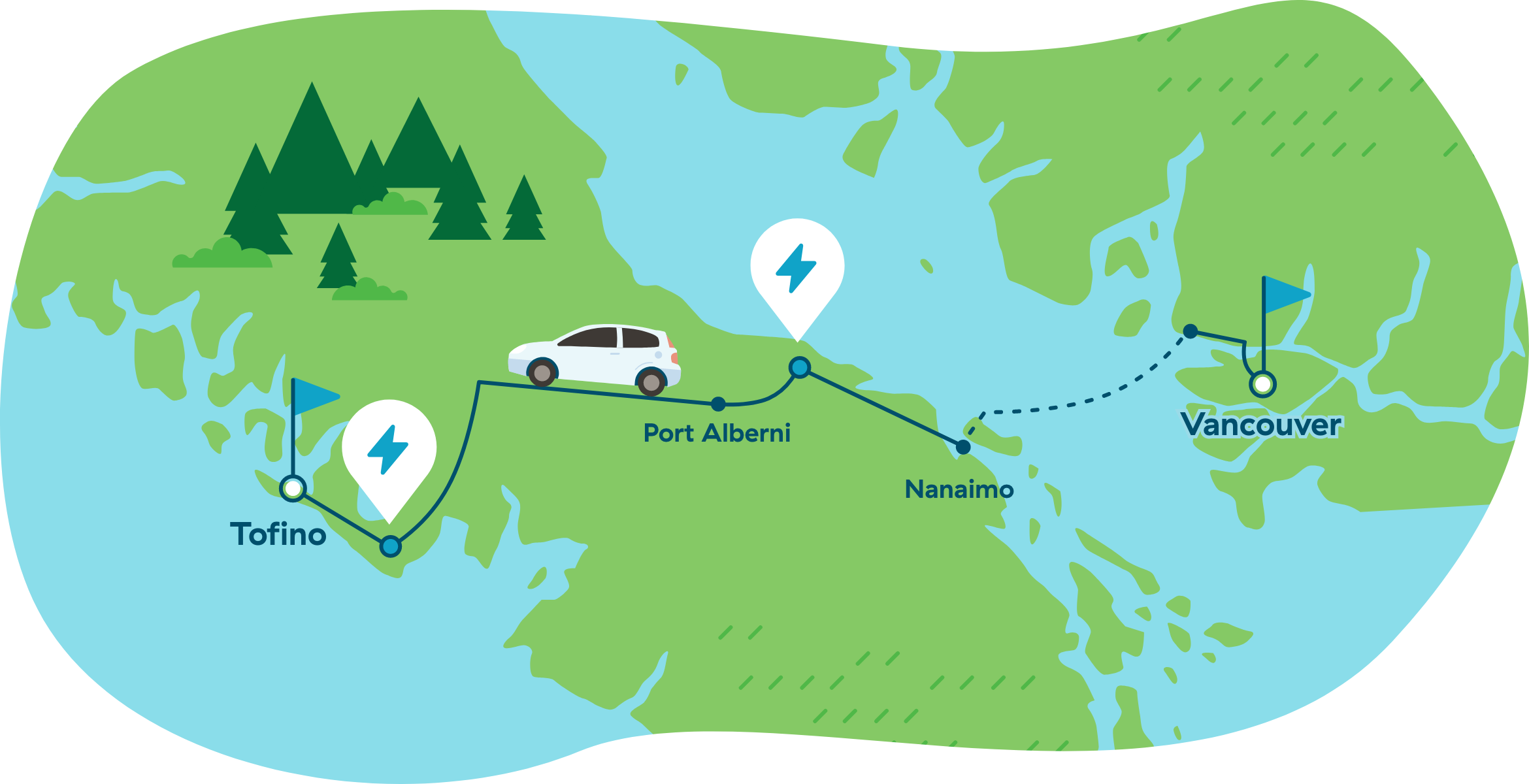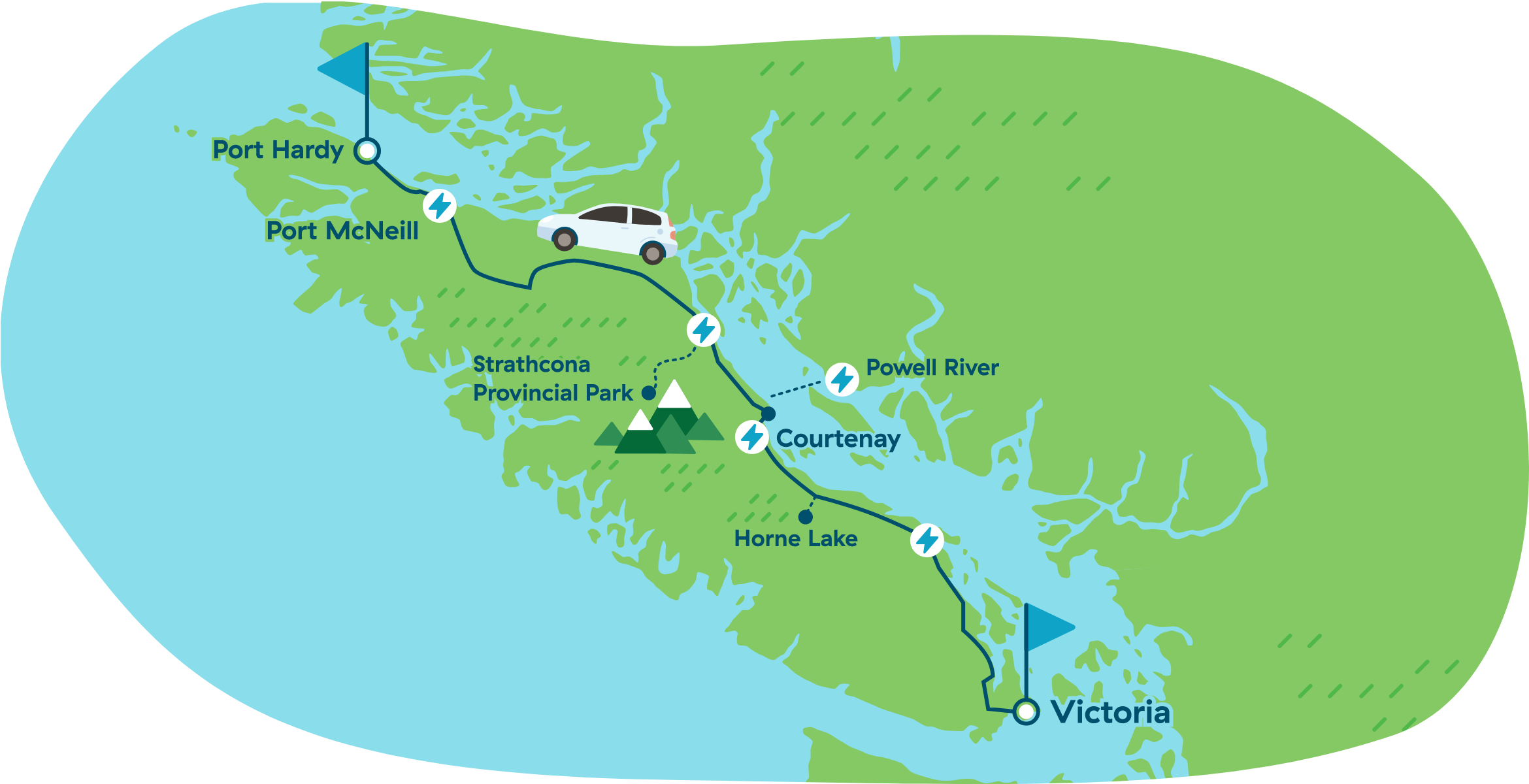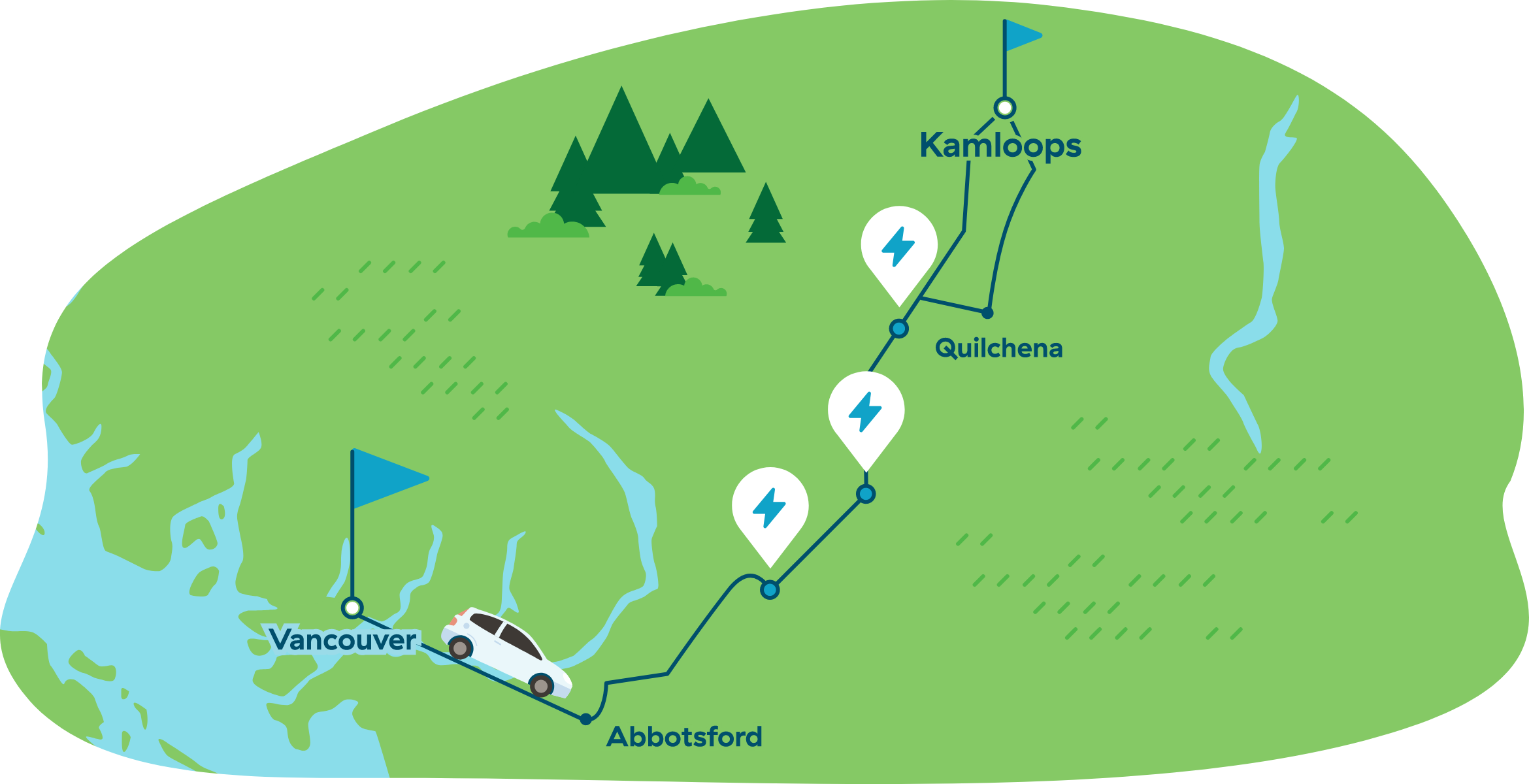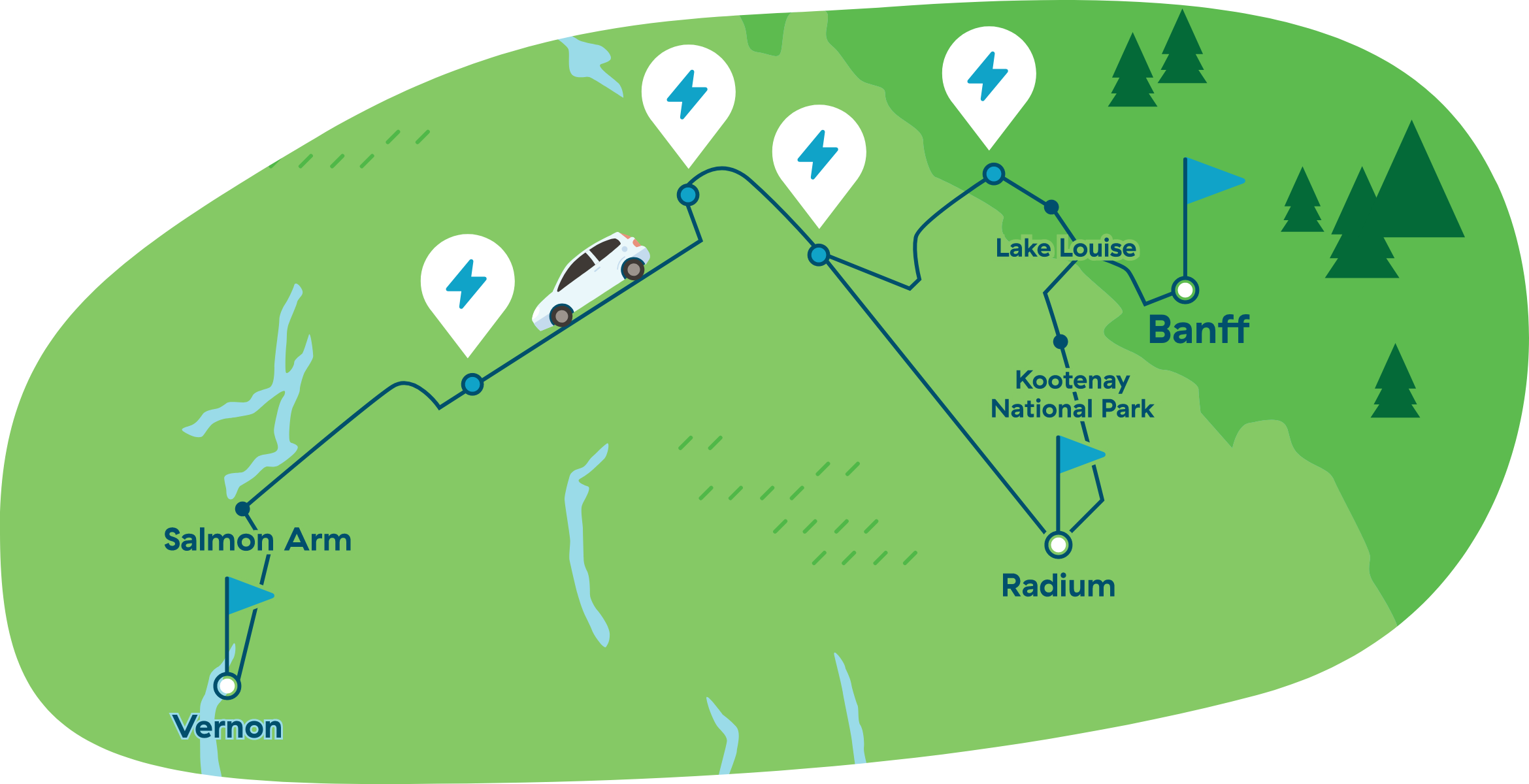New technology and B.C.'s EV charging network make it possible
Once considered primarily as a low-carbon option to the daily commute, electric vehicles (EVs) are breaking out of city limits as a fast, fun, and convenient road tripper.
Put range anxiety at ease
EV ranges are increasing all the time. In 2023, the average range of EVs available in B.C. was over 400 km, more than enough to make the lengthy drive from Kamloops to Vancouver without recharging your car's battery pack. The variety of affordable electric vehicles is also expanding to accommodate the needs of families and others who want space for five or more passengers and/or generous cargo space.
Just as important to the road tripper is the availability of fast chargers along the highways of B.C. Depending on your EV model, you can plug in and charge your car to almost full capacity in 30 minutes or less.
There are now hundreds of EV fast chargers across the province, many of which are operated by BC Hydro. That's in addition to the thousands of Level 2 public chargers.
Read the report: EV range anxiety and the realities of how far British Columbians drive on road trips [PDF, 350 KB]
Tips for EV road trips
The public charging network in B.C. and beyond is expanding fast, but any experienced EV driver will tell you that it takes some planning, and a few key considerations, to make for carefree road trips.
4 EV road trip ideas
1. Vancouver to Tofino
Distance one way: 238 km (or 317 km from Victoria)
Vehicle: 2020 Chevy Bolt (417 km range)
Charging stops: 1

How it's done: The Bolt gets you to the wild west coast of Vancouver Island without stopping, and allows you to recharge for the return leg at the Pacific Rim Visitor Centre. You won't have to stop on the way, but you should… for a bite at Qualicum Beach, a walk among the giant Douglas Firs at Cathedral Grove, to shop at the Old Country Market (with goats on the roof) at Coombs, or to fill a growler at Twin City Brewing in Port Alberni.
Trip highlights:
- Giant Douglas Firs at Cathedral Grove
- Shopping (and goats on the roof) at Coombs
- Storm watching, surfing or beach walking at Tofino
- Splurge at the Wickaninnish Inn or Middle Beach Lodge
- Camp on the beach at Bella Pacifica
- Take a boat (or float plane) for a hike and soak at Hot Springs Cove
2. Victoria to Port Hardy
Distance: 497 km (one way)
Vehicle: 2020 Kia Soul (383 km range)
Charging stops: 1

How it's done: In the Soul you can easily travel up and down Vancouver Island . As of fall 2020, there are new stations and many existing high use stations have been twinned to accommodate more vehicles. Take it slow, there’s a lot to see on your journey north. Stop to pick up provisions for a picnic on the beach while you charge up in Courtenay, then continue on north, and settle into a wilderness escape in Port Hardy to experience kayaking, hiking, and other outdoor adventures. On your way home, enjoy hiking amongst the wildflowers in Strathcona Provincial Park, the oldest provincial park in British Columbia.
Trip highlights:
- Eat fresh local cheese from Little Qualicum Cheeseworks
- Walk along the endless sandy beaches in Parksville
- Catch the ferry from Comox to the Sunshine Coast for a side trip
- Take a fishing charger in the Queen Charlotte Straight
- Whale watching in Port McNeill
- Visit the Horne Lake Caves
- Hike the Forbidden Plateau in Strathcona Provincial park
3. Vancouver to Kamloops: Golf trip
Distance one way: 361 km to Kamloops
364 km for return
Vehicle: 2020 Nissan Leaf S Plus (363km)
Charging stops: 1

How it's done: Depending on which battery pack you opt for, the Leaf will take you 363 km between charges. For this golf adventure to Kamloops, we've planned a single stop each way at the fast charger in Hope, in part because you can recharge with coffee and a quick bite at the nearby Blue Moose. While this trip is mostly about the fantastic golf Kamloops has to offer, we've built in a few options, including a round of golf at Sandpiper Golf Resort at Harrison Mills on the way up, fishing at Lac Le Jeune Resort, and a scenic drive on the old highway between Kamloops and Merritt.
Trip highlights:
- Golf, and eagle watching, at Sandpiper
- Soup and a fast charge in Hope
- Mountain splendour en route to the Coquihalla summit
- Trout fishing at Lac Le Jeune
- Kamloops golf at Tobiano, Eagle Point, The Dunes, Rivershore and Kamloops Golf & Country Club
- Optional day trip to Talking Rock Golf Club on the Shuswap
- Lakes, hills and the Quilchena Hotel on the old Kamloops-to-Merritt Highway
4. Vernon to Banff & Radium
Distance: 692 including Radium loop back to Golden
Vehicle: 2020 Hyundai Kona (415 km range)
Charging stops: 1

How it's done: The Kona's excellent range gets you all the way to a BC Hydro fast charger at Golden. En route to Banff, you can top up at a fast charger at Yoho, or at a Level 2 once you're in Banff. Consider a night in Salmon Arm, Revelstoke or Golden before heading to the Rockies, Banff and Radium Hot Springs. This trip is all about mountain scenery and recreation, and if you're a fit hiker, don't miss out on the Floe Lake trail en route to Radium. If you're camping, book your spots early. And if you're an avid skier/snowboarder, your journey ends at Revelstoke Mountain Resort, which boasts great snow and the longest groomed run (15.2 km) on the continent.
Trip highlights:
- Camping at Salmon Arm or Revelstoke
- Salmon Arm Roots & Blues Festival
- Hiking, mountain biking or skiing in Revelstoke
- Skiing, or Pipe Mountain Coaster in the summer, Revelstoke
- River rafting on the Kicking Horse River, Golden
- Banff Mountain Film Festival
- Hiking (or the gondola) in Banff
- Hiking Floe Lake Trail
- Soak at Banff or Radium Hot Springs
Watch Dave's road trip
Dave drove an EV from one edge of B.C. to the other
In 2019, cameras followed BC Hydro's Dave Mix on his 'Clean Getaway' road trip from Tofino on Vancouver Island to Yoho National Park in the Rocky Mountains, a trip that cost him about $30 at a combination of Level 2 and fast charge stations across B.C.


